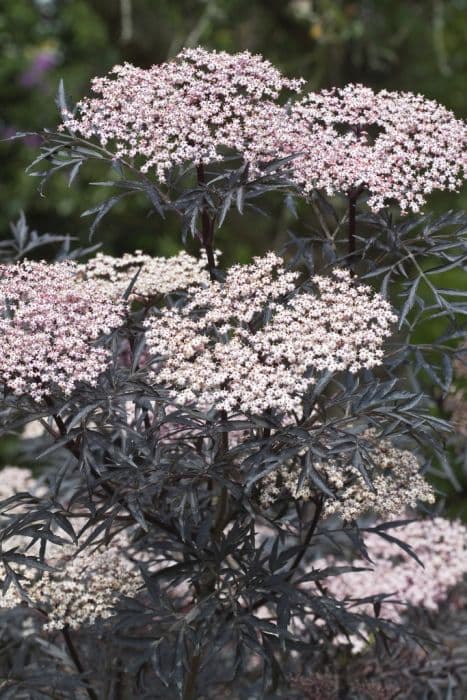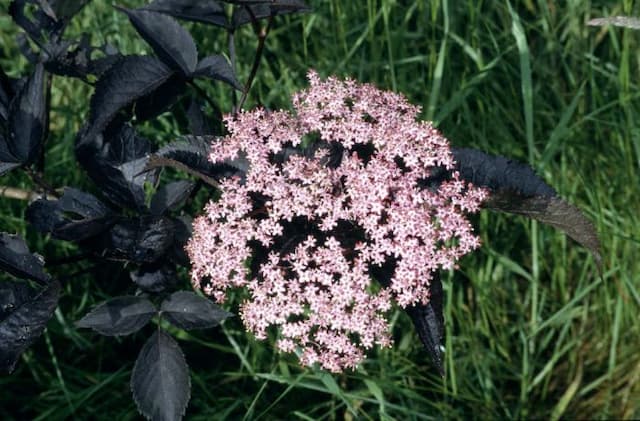Birchleaf Viburnum Viburnum betulifolium

ABOUT
Viburnum betulifolium, commonly known as the Birchleaf Viburnum, is a type of shrub that is well-regarded for its attractive appearance. Notable for its foliage, which bears a resemblance to that of birch trees, the leaves of the Birchleaf Viburnum are pointed and have finely serrated edges, lending a delicate and textured look to the plant. The leaves are arranged in an opposite fashion upon the branches, which adds to the plant's lush, full-bodied aesthetic. During the blooming season, the Birchleaf Viburnum produces clusters of small, creamy-white flowers that come together in cymes, contributing a showy display that is both fragrant and visually appealing. These blossoms are known to attract various pollinators and are often a highlight of the plant's growing season. Following the flowering stage, the Birchleaf Viburnum develops small, round fruits that can range in color from red to black when fully ripe. These fruits are not only a food source for wildlife but also provide a striking contrast against the foliage, adding to the ornamental value of the shrub. As the seasons change, the Birchleaf Viburnum’s leaves may transform into attractive autumnal shades, providing a display of fall color that can include hues from yellow to reddish-purple. This characteristic makes it a versatile and desirable plant for gardeners looking to add multi-seasonal interest to their landscapes. With its appealing characteristics, the Birchleaf Viburnum is often planted for both its aesthetic and ecological contributions to garden settings.
About this plant
 Names
NamesFamily
Adoxaceae
Synonyms
Birchleaf Viburnum
Common names
Viburnum betulifolium.
 Toxicity
ToxicityTo humans
Viburnum betulifolium, commonly known as Birchleaf Viburnum, is not widely recognized for being toxic to humans. There is limited information available regarding its toxicity, and therefore caution should be exercised as with any plant not commonly consumed. As with many plants, there could be potential for mild stomach upset if ingested in large quantities or if an individual has a specific sensitivity to the plant. However, since there is no well-documented evidence of severe toxicity in humans, effects are typically not considered to be life-threatening or severe.
To pets
Birchleaf Viburnum is not known for being highly toxic to pets, such as dogs and cats. There is limited specific information about the toxicity of Viburnum betulifolium to pets, but many species of Viburnum are generally considered to have low toxicity. If pets accidentally ingest parts of the Birchleaf Viburnum, they might experience mild gastrointestinal upset, including symptoms such as vomiting or diarrhea. It is always wise to monitor your pet for any signs of distress after ingesting plant material and to contact a veterinarian if you are concerned about their health.
 Characteristics
CharacteristicsLife cycle
Perennials
Foliage type
Deciduous
Color of leaves
Green
Flower color
White
Height
10 feet (3 meters)
Spread
6 feet (1.8 meters)
Plant type
Shrub
Hardiness zones
5
Native area
China
Benefits
 General Benefits
General Benefits- Aesthetic Appeal: Viburnum betulifolium, commonly known as the Birchleaf viburnum, features attractive foliage and white flowers that enhance garden designs.
- Seasonal Interest: Offers year-round interest with white flowers in spring, berries in late summer, and vibrant fall foliage.
- Wildlife Attraction: Berries provide food for birds and the flowers attract pollinators, supporting local ecosystems.
- Privacy Screen: The dense growth habit can be used to create privacy screens or hedges in landscaping.
- Erosion Control: The shrub's root system helps stabilize soil on slopes, preventing erosion.
- Drought Tolerance: Once established, Birchleaf viburnum has good resistance to drought, reducing the need for frequent watering.
- Adaptability: It is adaptable to a range of soil types and pH levels, making it suitable for various landscapes.
- Low Maintenance: Requires minimal pruning and is generally free from serious pests and diseases, making it a low-maintenance option for gardeners.
- Versatility in Landscaping: Can be planted in groups or as a specimen plant, providing flexibility in garden design.
- Habitat Enhancement: Contributes to creating microhabitats for insects and small animals within its branching structure and foliage.
 Medical Properties
Medical Properties- Antioxidant: Viburnum betulifolium may contain compounds that exhibit antioxidant properties, which can help in reducing oxidative stress in the body.
- Anti-inflammatory: The plant may also possess anti-inflammatory effects, which could be beneficial in reducing inflammation.
 Air-purifying Qualities
Air-purifying QualitiesThis plant is not specifically known for air purifying qualities.
 Other Uses
Other Uses- Viburnum betulifolium, commonly known as Birchleaf Viburnum, can be planted to create a privacy hedge due to its dense foliage, offering a natural screen from neighbors or street traffic.
- The wood of Birchleaf Viburnum is occasionally used in woodcrafts and for making small handles or tools, owing to its hardness and fine grain.
- Birchleaf Viburnum's spring flowers are attractive to pollinators like bees, and planting it can enhance local biodiversity.
- The berries of Birchleaf Viburnum, though not commonly consumed by humans, can provide a source of food for birds and wildlife during the fall and winter months.
- Its leaves can be used to create a natural dye for fabrics or art projects, giving a range of colors from yellow to brown depending on the mordant used.
- As a native plant in some regions, Birchleaf Viburnum is used in restoration projects to support local ecosystems and soil health.
- This plant's branches and foliage can be included in floral arrangements and wreaths, offering a rustic and woodsy aesthetic.
- Birchleaf Viburnum can be used as a windbreak in landscaping, reducing wind speed and erosion in exposed areas.
- The unique texture and color of its bark can be featured for visual interest in winter gardens when most plants have lost their leaves.
- It can serve as an educational tool in botany and horticulture courses, serving as an example of the Adoxaceae family's characteristics and growth habits.
Interesting Facts
 Feng Shui
Feng ShuiThe plant_name is not used in Feng Shui practice.
 Zodiac Sign Compitability
Zodiac Sign CompitabilityThe plant_name is not used in astrology practice.
 Plant Symbolism
Plant Symbolism- Renewal: Viburnum betulifolium, commonly known as Asian Viburnum, often symbolizes the concept of renewal due to its ability to regenerate and bloom each year.
- Protection: The dense and robust nature of the Asian Viburnum is sometimes associated with protection, guarding spaces like a natural shield.
- Abundance: With its plentiful berries and flowers, the Asian Viburnum can represent abundance and the generosity of nature.
- Strength: The hardy qualities of the Asian Viburnum symbolize inner strength and resilience.
- Perseverance: Asian Viburnum's capacity to withstand various climates and conditions makes it a symbol of perseverance and adaptability.
 Water
WaterBirchleaf viburnum prefers consistent moisture, so you should water the plant deeply once a week, providing about 1 to 1.5 gallons of water each time. During hot or dry periods, this frequency may need to increase to twice per week to maintain moist soil conditions. It's essential to avoid waterlogging by ensuring that the soil drains well. Adjust watering in response to rainfall, reducing the amount given if there has been significant precipitation. During the winter months, you can reduce watering since the plant will be dormant and its water requirements will decrease.
 Light
LightBirchleaf viburnum thrives best in full sun to partial shade. The optimal spot provides at least four to six hours of direct sunlight per day, with some protection from intense afternoon sun in hotter climates. An east-facing or west-facing location where the plant receives bright morning or late afternoon sun would be ideal.
 Temperature
TemperatureBirchleaf viburnum is hardy and can tolerate a wide range of temperatures, generally from 30°F to 80°F. It is suited for USDA hardiness zones 5 through 8. The ideal temperature for promoting growth and flowering is between 60°F and 75°F. The plant can withstand brief periods of temperatures just below freezing, but prolonged exposure to conditions colder than 30°F may damage the plant.
 Pruning
PruningBirchleaf viburnum should be pruned to maintain shape and health, as well as to encourage blooming. Prune the plant immediately after it finishes flowering in late spring or early summer, as it blooms on old wood. Thinning out old branches every few years can improve the plant's vigor. Cut back any damaged or diseased branches as soon as they are noticed.
 Cleaning
CleaningAs needed
 Soil
SoilThe best soil mix for the Birchleaf Viburnum should be well-draining with high organic matter content. A mix combining loam, peat, and coarse sand typically works well, ensuring moisture retention while preventing waterlogging. The ideal soil pH should range between 5.5 to 6.6 for optimal growth.
 Repotting
RepottingThe Birchleaf Viburnum typically does not require frequent repotting. It is a relatively slow-growing shrub, and repotting every 3-4 years, or when the plant outgrows its container, should suffice. Be mindful of root crowding and upgrade the pot size accordingly to promote healthy growth.
 Humidity & Misting
Humidity & MistingThe Birchleaf Viburnum thrives in moderate humidity conditions; it doesn't require specific high humidity. Average room humidity should be suitable for this plant, but ensure the environment isn't excessively dry, as it may tolerate lower humidity levels less favorably.
 Suitable locations
Suitable locationsIndoor
Place Birchleaf Viburnum in bright indirect light, ensuring adequate space.
Outdoor
Plant in partial shade to full sun, water regularly, and mulch the base.
Hardiness zone
5-8 USDA
 Life cycle
Life cycleViburnum betulifolium, commonly known as Birchleaf Viburnum, begins life as a seed typically dispersed by wildlife. Upon germination, the seedling emerges, establishing a root system and a small rosette of leaves. As the plant transitions into the juvenile phase, it develops a stronger root system and stem, with the foliage increasing in size and quantity. The maturation stage follows, with the Viburnum betulifolium reaching its full size, producing flowers that are pollinated by insects leading to the development of small berries. These berries contain the seeds, which when mature, are eaten and then dispersed by birds and other animals, completing the plant's reproductive cycle. Throughout its life, Birchleaf Viburnum may experience periods of vegetative growth and dormancy in response to seasonal changes.
 Propogation
PropogationPropogation time
Early Spring
Propogation: Viburnum betulifolium, also known as Birchleaf Viburnum, is commonly propagated through softwood cuttings. This technique usually occurs in late spring or early summer when the plant’s new growth is beginning to mature but is still flexible. To propagate, one would cut a 4 to 6-inch (about 10 to 15 centimeters) section of softwood from the tip of a branch, making sure it includes at least two or three sets of leaves. The lower leaves are then removed, and the cut end is dipped in rooting hormone to encourage root development. The cutting is then placed in a well-draining potting mix, kept moist, and provided with a high level of humidity, often by covering it with a plastic bag or sheltering it in a greenhouse environment. Roots typically develop within a few weeks, after which the new viburnum plant can be transferred to a larger container or planted directly into the garden.









